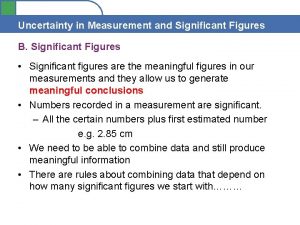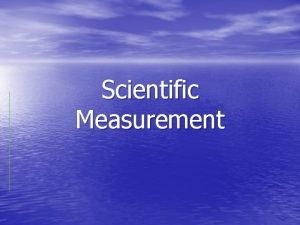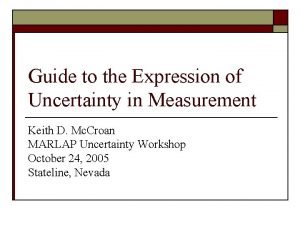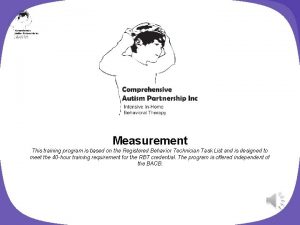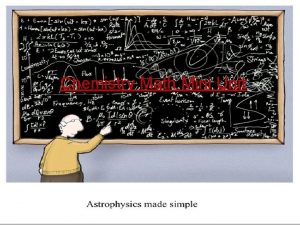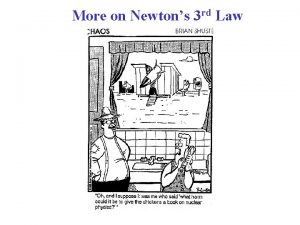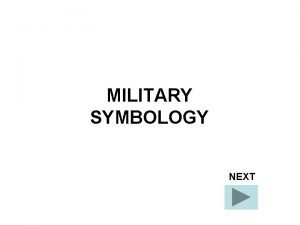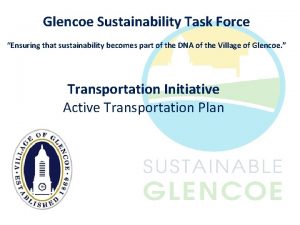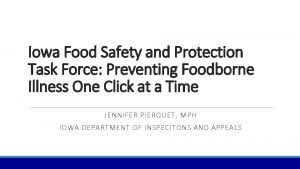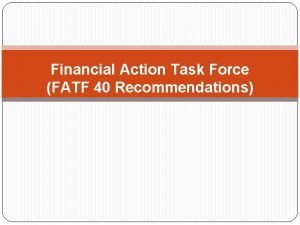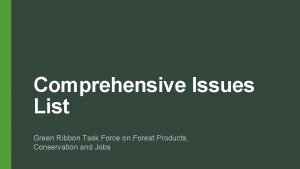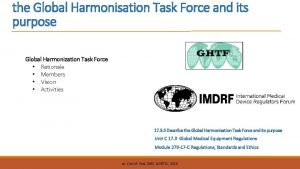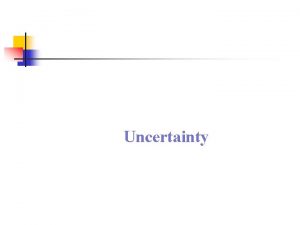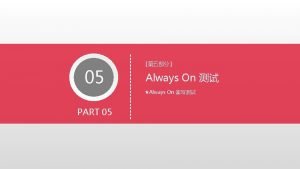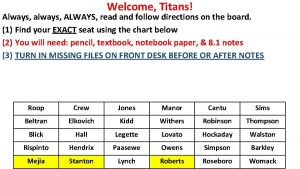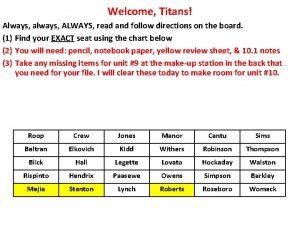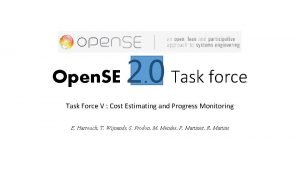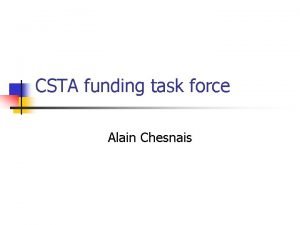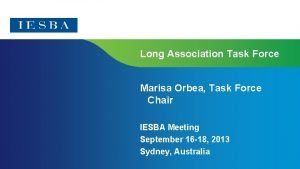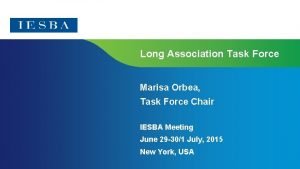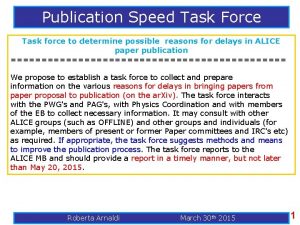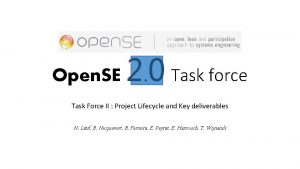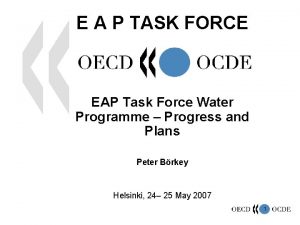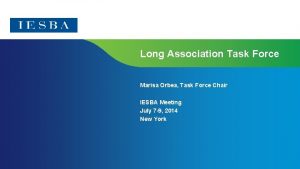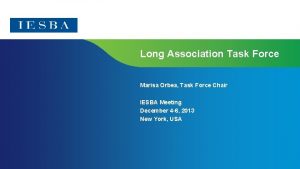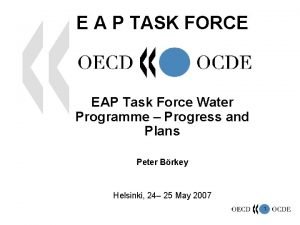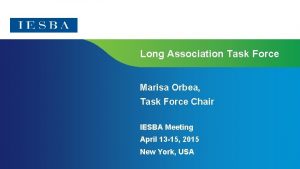Task Force Measurement Uncertainty Measurement procedures are always




















- Slides: 20

Task Force Measurement Uncertainty Ø Measurement procedures are always affected by factors causing disturbances leading to variation in the results observed by the same subject Ø Source and nature of these perturbations are not completely known and can sometimes affect the end result in a non-predictable way Ø A measured result shall be understood as an approximation to the true result, which by itself is unknown. Ø Two measurements are deemed to provide the same result if their test results are within the given uncertainty. Ø Two vehicles are deemed to provide the same sound level, if their measurement results are within the given uncertainty. Ø Thus, the knowledge of the measurement uncertainty is important as it provides information about the precision and repeatability of measurements. Ø The measurement uncertainties shall be minimized, e. g. by narrowing ambient and test conditions or by correction. Ø Any residual uncertainty shall be covered by tolerances.

ISO/IEC Guide 98 -3 (Guide to the expression of Uncertainty in Measurement) Ø The uncertainty of results obtained from measurements can be evaluated by the procedure given in ISO/IEC Guide 98 -3 (GUM) or by interlaboratory comparisons in accordance with ISO 5725 (part 1 to 6) Ø The procedure given in ISO 5725 (part 1 to 6) to estimate the uncertainties associated with the test procedures mentioned in UN Regulation No. 51. 03 or No. 117. 04 (for Rolling Sound) is not followed, as extensive inter- and intra-laboratory data are not available for the calculation of the uncertainties. Ø Instead, the procedure given in ISO/IEC Guide 98 -3 (GUM) can be followed to estimate the uncertainties associated with the test procedures mentioned above. Ø The data for the calculation of the uncertainties are based on existing statistical data, analysis of tolerances and engineering judgement and can be grouped as follows for Ø the same vehicle ü Run to Run ü Day to Day ü Site to Site Ø different vehicles of the same kind ü New Vehicle to new Vehicle or, new Vehicle to used Vehicle

How to Handle Uncertainties in a Regulation Ø A Regulation provides boundary condition for environment and other parameters, to control already in a basic manner come uncertainties Ø At the beginning and at the end of every measurement session the entire measurement system shall be checked by means of a sound calibrator… Without any further adjustment the difference between the readings of two consecutive checks shall be less than or equal to 0. 5 d. B(A). ” Ø “The road speed of the vehicle shall be measured with instrumentation having an accuracy of at least ± 0. 5 km/h, when using continuous measurement devices” Ø “Before the measurements are started, the engine shall be brought to its normal operating conditions. ” Ø “The air temperature shall be between 5°C and 40°C” Ø Manufacturer can handle part of the uncertainty by selecting the test track, the measurement equipment and partly the ambient conditions. Ø An expanded uncertainty on production variation is already granted for according to Annex 6 of UN R 51. 03 for Conformity of Production (Co. P) Ø “If the sound level of the vehicle tested does not exceed by more than 1 d. B(A) the limit value specified in paragraph 6. 2. 2. of this Regulation, and, where appropriate, paragraph 3. of Annex 5, the vehicle type shall be considered to conform to the requirements of this Regulation. ” Ø Third party testing such as in-use conformity and market surveillance provide further uncertainties, which are not covered by the scope of UN Regulations.

Strategic Approach to Cover Measurement Uncertainties Ø Measurement Uncertainties can be minimized by various measures, which have all advantages and disadvantages. Ø Possible measures are: Pos. Measure Advantage Drawback 1 Narrow the application range to minimize external influences Scientifically most preferable to have uniform test conditions Practically not possible for outdoor measurements, not realistic for real world conditions 2 Introduce compensation models Allows larger application range Not always applicable, introduces own uncertainties 3 Apply tolerances Simple, considerable for nontype approval measurements Could be understood as weakening of applied limits 4 Statistical compliance Already introduced system for Co. P Some vehicles not fully compliant to the regulation 5 Repeat measurements under type approval conditions Most accurate procedure Difficult to arrange Ø A mix of all these measures can ensure a sufficient large control range to reflect real world conditions in a statistically relevant way and keep the precision of the test method in a technically and politically acceptable range. Ø Limits have an impact on the source distribution of vehicles and components. Different source compositions result different sensitivities on uncertainty parameters. Enforcement of limits shall consider such sensitivities. Ø In a first approach, it is essential to get an overview about the biggest influence factors of a test procedure.

Uncertainty Estimate Based on the GUM Assessment Principles for UN R 117 Ø By applying the general numerical approach with the GUM, for carrying out calculations required as part of an evaluation on measurement uncertainty, the actual uncertainty for tyre rolling sound measurements according to UN R 117 are provided by the table below:

Ø By applying the general numerical approach with the GUM, for carrying out calculations required as part of an evaluation on measurement uncertainty, the actual uncertainty for UN R 51. 03 for vehicles with combustion engine is provided by the table beside: Impact based on experiences of manufacturer Uncertainty Estimate Based on the GUM Assessment Principles for UN R 51. 03

Ø By applying the general numerical approach with the GUM, for carrying out calculations required as part of an evaluation on measurement uncertainty, the actual uncertainty for UN R 51. 03 for electric vehicles is provided by the table beside: Impact based on experiences of manufacturer Uncertainty Estimate Based on the GUM Assessment Principles for UN R 51. 03

Narrowing the Application Range Ø Proposals for narrowing refer mostly to ambient conditions Ø However, the ambient conditions should be kept as wide as possible to reflect real world driving. Ø Ambient conditions, which have a well known important impact on the test result are: Ø Air temperature Ø Road surface temperature Ø Air pressure Ø Proposals for consideration: Ø UN R 51. 03 specific: Ø include test track temperature and test limits according UN R 117 (5°C up to 50°C test track surface temperature) Ø For tests other than type approval: consider a more narrow control range Ø UN R 117. 04 specific: Ø T. b. d. Ø General: Conduct, if necessary, tests on the same test track and with the same equipment which was used during type approval Ø More items t. b. d.

Compensation for Influence Factors – Temperature an Test Track Today available compensation procedures Temperature correction e. g. according to UN R 117 or ISO 13255 ISSUE: The „VDA“ formula might be an interesting approach, however, validation is still needed for a general use on all ISO 10844 test tracks and for any tyre dimension. Test track compensation by one of the following methods Method A Correction calculation based on test track parameters – description of the calculation could be subject of an extension of the ISO 10844 or could be done in an own standard IDEA FOR DISCUSSION: For each tyre, which a manufacturer nominates as version to the vehicle type, free rolling sound data could be made available. Method B Correction based on an additional free -rolling noise measurement data, delivered during the approval process.

Compensation of the Pass-by Noise Temperature Correction (based on UN R 117) Ø In UN R 117, the temperature correction is based on the test track surface temperature. This is actually not requested to be reported in UN R 51. 03. Ø In UN R 117, the temperature correction is made to a reference temperature of 20°C. For the application in UN R 51. 03, the temperature correction shall be done to the temperature stated in the test report of the type approval test.

Compensation for the Influence of the Test Track – Method A, based on a universal formula

Compensation for the Influence of the Test Track – Method B, based on available tyre rolling sound information Ø The tyre rolling sound information should be determined in the course of homologation. Ø The data might be determined independent from the type approval test for the vehicle to which the tyre might be mounted. Ø The same tyre might be used for different vehicle types.

Update of the Uncertainty Sheets based on the Compensation Ø By applying a compensation for the temperature the originally estimated uncertainty will become lower. Ø However, there is no universal „true“ compensation model. Ø The temperature sensitivity of a tyre is dependent on the design and materials used in the tyre. Ø As no discrete results exist, a conservative guess is made, that the uncertainty is reduced by 50%, e. g. for UN R 51. 03 from 2 d. B(A) to 1 d. B(A). Ø The test track compensation is as well subject to uncertainties. Ø Even when using measurements of the same tyre on the test tracks, the residual uncertainty will apply to both measurement. Ø By good engineering judgement, the uncertainty is considered to be lowed from 5 d. B(A) under cruise condition to 1. 5 d. B(A) for both combustion engine vehicles and those with electric propulsion. Ø The following slides show the result of the compensation

Improved Uncertainty Estimate After Corrections for Temperature and Test Track (UN R 51. 03) Impact based on experiences of manufacturer Ø By applying the general numerical approach with the GUM, for carrying out calculations required as part of an evaluation on measurement uncertainty, the actual uncertainty for UN R 51. 03 for combustion engine vehicles is provided by the table beside: was: 2. 78 d. B(A)

Improved Uncertainty Estimate After Corrections for Temperature and Test Track (UN R 51. 03) Impact based on experiences of manufacturer Ø By applying the general numerical approach with the GUM, for carrying out calculations required as part of an evaluation on measurement uncertainty, the actual uncertainty for UN R 51. 03 for electric vehicles is provided by the table beside: was: 3. 41 d. B(A)

Further Steps Ø The updated Excel tables with the applied compensation for show the residual uncertainty of the test procedure. Ø By narrowing of the application range for Co. P or other tests, which are not subject to the UN framework, the uncertainty can be further improved. Ø The share of the individual influence factors become more harmonized, which means that tuning an individual parameter will have less impact on the overall test result the test method becomes more robust. Ø The residual uncertainty is subject to consideration on additional tolerances or statistical compliance. Ø Proposal for consideration: Ø Applicable additional extended uncertainty tolerances for Ø Type Approval: NONE Ø Co. P: 1 d. B(A) relative to the limit values, this is already implemented in Annex 6 of UN R 51. 03 Ø Other tests outside the scope of UN Regulations: 2 d. B(A) relative to the limit values Ø Statistical Compliance or repetition of the test under conditions comparable to the type approval condition: Ø If one vehicle fails, two more vehicles shall be tested see Annex 6 to UN R 51. 03 Ø Alternatively, the manufacturer may ask to test the vehicle on the test facility onwhich the original type approval test was performed.

BACKUP MATERIAL

Conclusion Ø Updated Excel tables with optimized parameters residual uncertainty Ø How to handle residual uncertainty Ø Back slides from VENOLIVA

VENOLIVA STUDY on UN R 51. 03 (EU COM 2011) 10. 3 Evaluation of test method B The practicability and manageability of method B was investigated by means of a small enquiry among a number of type approval authorities that had submitted significant numbers of test report files for the database. Based on the response from these type approval authorities the following conclusions can be drawn: Ø The complexity of the new method B for light vehicles (M 1, N 1 and N 2 < 3, 5 t) is approximately three times higher than of the current method A; Ø For these vehicles method B requires more attention to avoid errors and to achieve the necessary measurement accuracy than method A; Ø Depending on the type of measuring equipment (fully integrated or separate systems) the management of the test process may be rather time consuming; Ø Method B is more sensitive to environmental parameters, because the test results for light vehicles are lower than for method A; Ø Nevertheless, method B is considered reproducible and manageable; The VENOLIVA STUDY of the European Commission from 2011 on the introduction of the new test procedure (method B) concludes a higher sensitivity with regard to measurement accuracy and ambient conditions compared to the old test procedure (method A)

VENOLIVA STUDY on UN R 51. 03 (EU COM 2011) 8. 6 Optimisation of vehicles to the test method (M 1 Vehicles) Ø The current test method A has been in force for a very long period. Vehicle manufacturers have learnt to take the test conditions and the type approval requirements into account in the design process of the vehicles. Ø This adaptation or optimisation to the test method has not yet taken place for test method B, which is new and was applied on a large scale for the first time during the monitoring period. Ø The histograms for method A cut off sharply at the limit values, while the histograms for method B show a more natural tapering off to higher sound emission levels. Ø Based on the differences between the histograms for test methods A and B for these vehicles it may be assumed that after some time the results of test method B will show a similar high end cut off as the results of test method A. Ø The highest values will then be 72 or 73 d. B(A). Diesel The basic limit for M 1 vehicles was set to 72 d. B(A) and included the assumption that manufacturer will „learn to take the best conditions into account“.
 Insidan region jh
Insidan region jh Significant figures cartoon
Significant figures cartoon Measurements and their uncertainty
Measurements and their uncertainty Guide to the expression of uncertainty in measurement
Guide to the expression of uncertainty in measurement Always low prices
Always low prices Implement permanent product recording procedures
Implement permanent product recording procedures Tiered task bias task
Tiered task bias task Why must a given measurement always
Why must a given measurement always Is normal force always equal to weight
Is normal force always equal to weight S330 nwcg
S330 nwcg Expected armored cavalry troop symbol
Expected armored cavalry troop symbol Glencoe sustainability task force
Glencoe sustainability task force R.e.a.c.t. task force
R.e.a.c.t. task force Www.youtube.com
Www.youtube.com Fatf 40 recommendations
Fatf 40 recommendations Green ribbon task force
Green ribbon task force Princeton policy task force
Princeton policy task force Desktop management task force
Desktop management task force Anchor institutions task force
Anchor institutions task force Global harmonization task force
Global harmonization task force Social performance task force
Social performance task force

